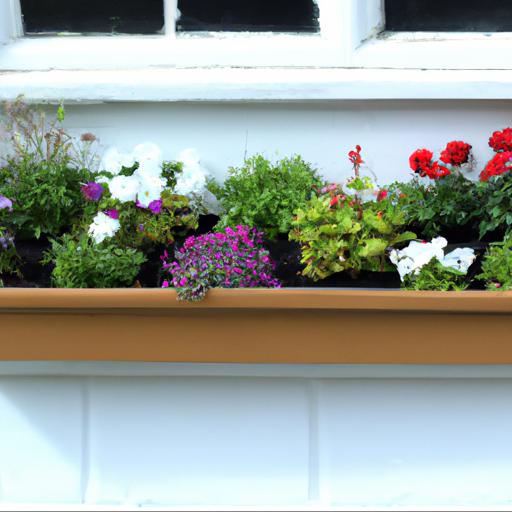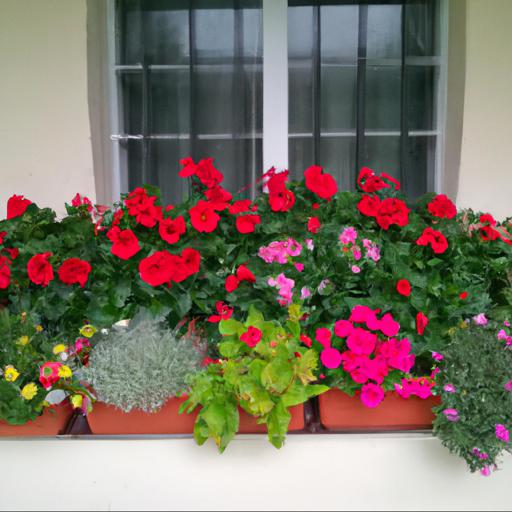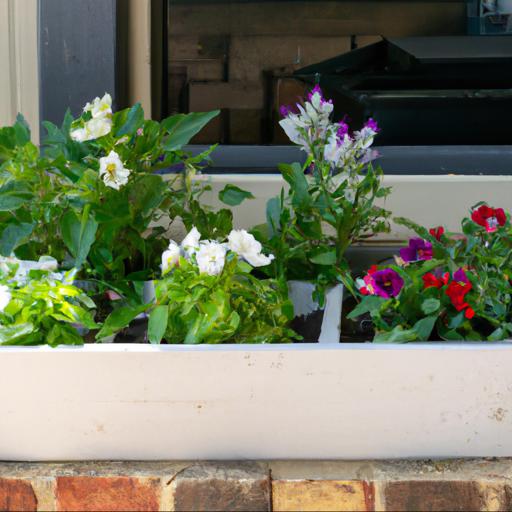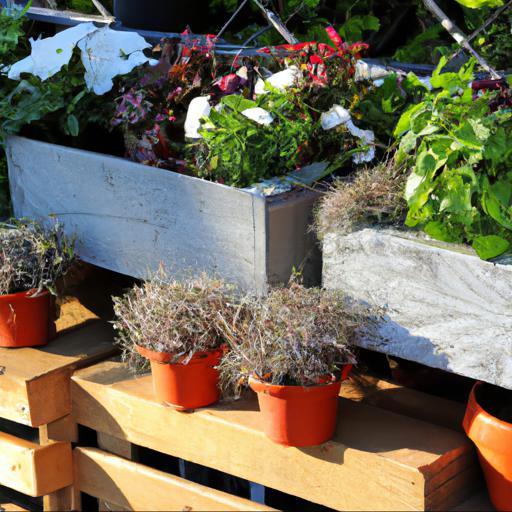Window boxes are a great way to add a touch of nature to your home. Not only can they provide a splash of color, but they can also be a great way to grow your own herbs, vegetables, and flowers.
Plants for window boxes can be chosen to suit your particular climate and taste, from low-maintenance succulents to bright and cheerful blooms. With the right combination of plants, you can create a unique and vibrant window box that will bring life to your home.
Benefits of growing plants in window boxes

Window boxes have become a popular choice among gardeners and homeowners looking to spruce up their outdoor spaces. Whether you’re looking to add color to your balcony, create an oasis on your windowsill, or draw attention to beautifully designed architecture, window boxes can be an easy and cost-effective way to do so.
Positioned on plain windows or balconies, window boxes can dramatically increase curb appeal and complement the existing architecture. But, did you know that in addition to their aesthetic appeal, window boxes can also provide a great way to grow edible plants and flowers? By taking advantage of window box gardening, urban homeowners and renters can cultivate a variety of different plants within limited space.
Here are some of the top benefits of growing plants in window boxes. One of the primary advantages of window boxes is the potential for enhanced productivity with limited space. Even if you don’t have a lot of available space in your yard, you can use window boxes to create a productive oasis right on your windowsill.
From herbs and greens, to potted tomatoes and peppers, window boxes can be used to create an entire kitchen garden if desired. Gardening in window boxes is also ideal for renters or those living in urban areas, since many can be easily mounted and removed when needed.
Window boxes also help to instantly add visual value to buildings and gardens with their vivid colors and shapes. You can choose from a variety of different colors and sizes to suit your décor and outdoor space.
If you choose flowering plants for your window boxes, you’ll also benefit from a season-long show of color and texture. Lastly, window box gardening can increase the curiosity of passers-by, as well as your overall enjoyment. For instance, if you are entertaining guests, create a show-stopping window box feature, like a living wall of edible vines such as those of beans, squash, or tomatoes.
Not only will it draw the attention of anyone walking past, it will also add a functional source of vegetables to your table. In conclusion, window boxes provide a great opportunity to cultivate plants without having a lot of yard space. Homeowners, renters, and city dwellers alike can benefit from this type of gardening and easily grow flowers, vegetables, and herbs. As a bonus, window boxes can also be used to boost the overall look and feel of a property.
Types of plants suitable for window boxes

Window boxes can be a great addition to any home as they add charm, color and life to exterior spaces like patios, decks, windows and balconies. These small gardens come with an array of possibilities for landscapers, big and small.
There is an array of different plants that can be used for window boxes for nearly any sunlight exposure or budget. Let’s have a look at what plants are suitable for window boxes. A common staple for window boxes is flowers.
Sun-loving flowers such as geraniums, petunias, impatiens, dianthus, lobelias, and marigolds are excellent in hanging baskets and look stunning cascading over edges of window boxes. With mixed annuals and perennials, you’ll be able to create colorful displays that last all season.
Sun-loving perennials like bee balm, sedums, and coreopsis are also good choices for window boxes. Vines and trailing types of plants are ideal for window boxes as they can be trained to hang down nicely, adding an element of movement and texture. Vigorous vining plants such as ivy, morning glory, and clematis do especially well and often bear colorful flowers.
Foliage plants such as ivies, sweet potato vine, and Swedish ivy are also great for window boxes and come with the added bonus of having interesting textures and leaf shapes. Finally, for shady window boxes, plant types such as coleus, caladium, ferns, hostas, and impatiens are all great choices. With a bit of creative color combinations and planning, you can have some of the most stunning window boxes surrounding your home.
To make your window boxes even more attractive, include herbs like basil and oregano, or vegetables such as lettuce or mizuna for a pop of green. All of these plants, especially if species native to your local area, can make beautiful window box arrangements.
Tips for planting and caring for window box plants

A window box is a great way to add both visual appeal and a burst of colour to any outdoor space. Whether you’re an experienced gardener, or a complete beginner, adding plants to your window box can be a rewarding experience. To make sure your window box planting project is a success there are a few important pointers to bear in mind.
When it comes to choosing plants for window boxes the options are vast. Remember to select plants that are appropriate for your level of gardening expertise and the climate in which you live.
Suitable plants might include evergreen shrubs, perennials, herbs, annuals, trailing climbers such as ivy, or a combination of these. When picking plants consider how much sun your window box receives, and if you’re looking to add colour choose a mix of both flowers and foliage in a range of hues. Before you begin planting, ensure your window box is in good condition and it is well secured to the wall.
Fill the box with potting compost, and set your plants in their places before carefully filling the box with compost to make sure the roots are securely covered. Water your plants gently, making sure that the excess drains away.
Regularly check to see that your window box is getting enough moisture, but not too much, to prevent your plants from becoming water-logged. Finally, deadhead spent blooms and regularly feed your plants with a suitable fertilizer to keep them looking their best.
A window box can be an easy-care way to add appeal to your outdoor space; all that’s needed is a little creativity and regular maintenance.
Creative ideas for window box plant displays
Creating an attractive and eye-catching window box plant display doesn’t have to be a challenging endeavour. With a well-planned design, the perfect selection of plants, and a little bit of effort, you can create a beautiful frame for your windows that will make your neighbours envious.
To start, you’ll want to determine the size and shape of your window box, and the type of plants you want to use. Taller and bushy plants, such as sunflowers, will add drama to a window box, while trailing plants such as ivy or ferns can cascade down over the sides. Lilies, begonias, and impatiens are all low-growing plants that will easily fill a window box and provide a thrill of colour throughout the season.
You could also add some evergreen plants, such as boxwood, to add an element of texture and provide year-round interest. Once you have the plants sorted, you need to think about the layout of your window box. Arranging them in an alternating pattern will add interest to the display and make it look neat and organised.
If you’re looking to add some extra interest, consider having a “thriller” plant at the centre of the display, such as a tall grass or a striking foliage plant, as well as “spillers” like trailing petunias. When planting, be sure to use a high quality soil to ensure your plants are healthy and thriving.
And, don’t forget to add some liquid fertiliser every few weeks during the growing season to keep your plants looking fresh and vibrant. There are so many wonderful possibilities when it comes to designing utilizing window box plant displays.
With a little imagination and a lot of trial and error, you can create a stunning look for your home that will truly stand out.
Our video recommendation
Conclusion
Window boxes are a great way to add a touch of nature to your home. They are easy to install and can be filled with a variety of plants, from trailing vines to bright flowers. With the right selection of plants, you can create a beautiful display that will add color and life to your home.
No matter the size or shape of your window box, you can find a plant that will thrive in it.
FAQ
What type of plants are best for window boxes?
The best type of plants for window boxes are those that are compact and that thrive in full sun, such as petunias, pansies, and marigolds.
How often should window box plants be watered?
Window box plants should be watered at least once a week, or more often if the soil is dry.
What soil should be used for window box plants?
The best soil for window box plants is a light, well-draining potting mix. It should contain a combination of peat moss, compost, and perlite or vermiculite for aeration.
How much sunlight do window box plants need?
Window box plants typically need at least 6 hours of direct sunlight per day in order to thrive.
How can I protect window box plants from extreme temperatures?
To protect window box plants from extreme temperatures, you can move the window box to a sheltered area, such as a porch or balcony, and provide shade with a light-colored cloth or shade cloth. You can also insulate the window box with bubble wrap or other insulation material. Additionally, you can water the plants regularly to help regulate the temperature.
What are some of the most popular plants for window boxes?
Some of the most popular plants for window boxes are petunias, geraniums, impatiens, pansies, lobelia, and ivy.

